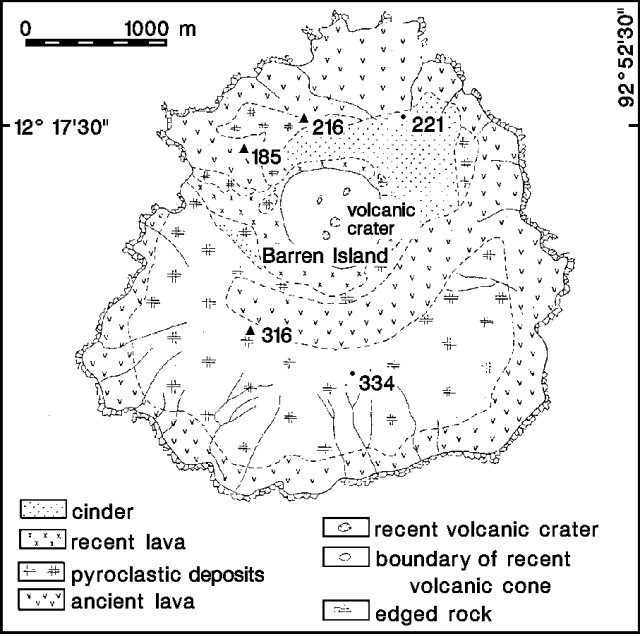Report on Barren Island (India) — May 1991
Bulletin of the Global Volcanism Network, vol. 16, no. 5 (May 1991)
Managing Editor: Lindsay McClelland.
Barren Island (India) Explosions and lava flows from NE flank vent
Please cite this report as:
Global Volcanism Program, 1991. Report on Barren Island (India) (McClelland, L., ed.). Bulletin of the Global Volcanism Network, 16:5. Smithsonian Institution. https://doi.org/10.5479/si.GVP.BGVN199105-260010
Barren Island
India
12.278°N, 93.858°E; summit elev. 354 m
All times are local (unless otherwise noted)
Reports of strong emissions of "thick smoke" on 30 April prompted a visit to the island on 16 May by geologists from the GSI [see additional information about the start of the eruption in 16:10]. Lava poured continuously from a subsidiary vent on the NE face of the central volcanic cone, travelling N into a valley, then W along the course of the 1803 lava flow (figure 1). An area of ~800 x 200 m had been covered by fresh lava, with an average thickness of 5-6 m. Explosions at the vent occurred at intervals of several seconds, ejecting bombs, lapilli, and ash to heights >50 m.
 |
Figure 1. Geologic sketch map of Barren Island, by D. Haldar, T. Laskar, and J.K. Biswas. Courtesy of the GSI. |
On 7 June at 1602, John Deed, pilot of Thai Airways International flight 307, observed a gray to dark-gray plume rising ~3 km above the summit and extending roughly 90 km NE. No lava was visible.
Geological Summary. Barren Island, a possession of India in the Andaman Sea about 135 km NE of Port Blair in the Andaman Islands, is the only historically active volcano along the N-S volcanic arc extending between Sumatra and Burma (Myanmar). It is the emergent summit of a volcano that rises from a depth of about 2250 m. The small, uninhabited 3-km-wide island contains a roughly 2-km-wide caldera with walls 250-350 m high. The caldera, which is open to the sea on the west, was created during a major explosive eruption in the late Pleistocene that produced pyroclastic-flow and -surge deposits. Historical eruptions have changed the morphology of the pyroclastic cone in the center of the caldera, and lava flows that fill much of the caldera floor have reached the sea along the western coast.
Information Contacts: Director General, GSI; Deputy Director General, GSI Eastern Region; T. Fox, ICAO.

